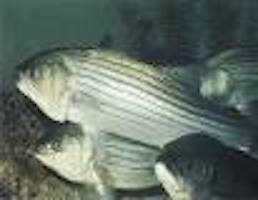Striped Bass Autumn Fishing

In early fall smaller feeder streams begin to cool to temperatures more than 10 degrees cooler than the lake surface.
Schools of forage fish move toward the stream channels at the beginning and end of the day followed closely by Striper bass.
How to fish freshwater Stripers
- Fish the openings of fast streams using a live minnow or shad hooked through both lips with a number 2/0 hook
- Weight the line about 1 or 2 feet above the lure, allowing the bait to reach the bottom
- Either slowly drag the bait or let the lure sit on the lake floor where it lands
- When a striped bass strikes, try letting it take 5 or 10 feet of line before setting the hook
This technique may be slow fishing, but it’s effective.
Fishing ocean going stripers
In saltwater Striped Bass feed with a frenzy after August as they anticipate the long migration ahead. Not all fish participate in the ‘great striped bass migration’, only those fish that have reached the age of 2 years participate.
Striped Bass take the same general path. They follow the shoreline northward and eastward and return westward and southward in autumn.
For saltwater use a strong hand line with an artificial bait consisting of a silver plated spoon, bucktails with plastic trailers and surgical tubes.
Trolling
Trolling is a very effective striped bass fishing technique for both freshwater and saltwater.
In our experience squid and eel have proven more successful for trolling than any other baits. When attaching a squid to a hook, pull the squid’s spine out and thread the line through it.
For freshwater keep the squid alive and hook the tail. Freshwater stripers can also be caught using alewives and other shads, threadfins, crayfish and trout.
If you’re lake fishing for striped bass at night you’ll usually need heavy spinning equipment and a 20lb test line. Cast a deep-running crankbait parallel to the shore in a rocky area that features a 10 or 20 ft drop-off. Pace the lure at a medium speed to ensure that the lure maintains its maximum depth.
At night, loud rattle crankbaits filled with split shot attract both striped bass and impressively sized largemouth’s.
Temperature sensitivity
Striped bass are affected by temperature variations in the same way as any other bass is affected. Their optimal water temperature is 63°F. Stripers will adjust their depth to stay within the thermal range.
When temperatures drop below this, Striped Bass begin to slow down with the larger fish slowing more than the smaller fish. These larger fish can be caught with cut bait. Bait that wouldn’t work on smaller, faster fish.
Surf Fishing
- Use swimming plugs and live eels with a 10ft to 12 ft surf rod and conventional reel.
- A 30 to 40 lb test monofilament line is recommended but you can get away with a heavy duty spinning rod with 12 to 20 lb test monofilament line. It’s great for plugging and jigging.
- Attach the lure to the line with a snap swivel and consider a pyramid sinker.
Many anglers overlook this bit of advise, but by applying a float you’ll keep the bait away from bottom dwelling crabs, dogfish and skate.


